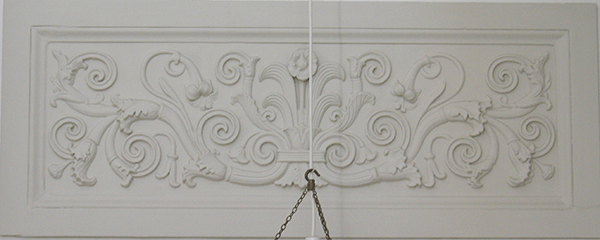The History of 9 Sussex Square
9 Sussex Square
1. History
2.Bas Relief
1 History
The characteristic plaque on the first floor of this house tells us that it was built by Thomas Cubitt. Although converted to flats, the building retains its Georgian townhouse layout including a separate kitchen block beyond the courtyard at the rear, now an individual household.
Pigot & Co’s 1840 Directory for Brighton records a John Sperling Esq resident at 9 Sussex Square and the 1841 census lists a sole occupier, 20 year old Lucy Briggs, presumably a servant, which supports the idea of the house as a seasonal home in this earliest period.
Firmer evidence exists for the use of the building from 1846 as a Ladies Boarding School under the auspices initially of Miss Sarah Hall, and subsequently of the Misses Hall, suggesting a school run by Sarah and one or more sisters. The 1861 census records a household of 15, just four of whom were pupils; ten years later this had grown to a scarcely believable 46 occupants, including 32 female pupils aged from eight to 18. Nine of these had been born in India, suggesting a strong link with the East India Company’s colonial administration.
The school closed some time between 1897 and 1902, when the building was first recorded as occupied by the physician and homeopath Dr Vernon Bell.
The lawyer and politician Sir Samuel Thomas Evans first appears in the street directories after 1912. Born in Skewen, Glamorganshire, in 1859, Evans was a lawyer and Liberal politician. First called to the Bar in 1891, he was the last QC to be appointed by Queen Victoria in 1901. He served as the Liberal MP for Mid Glamorgan from 1890 to 1910 when he was known for his anti-suffragist views. He was knighted in 1908, being appointed Solicitor General by Asquith the same year. Sir Samuel gave up politics in 1910 to become President of the Divorce, Probate and Admiralty Division of the High Court of Justice until his untimely death in September 1918.
As a judge his most noteworthy case was the infamous 1913 Scott Case – the “fight for the £1,000,000” as it was called at the time - involving Lady Sackville, who was Vita Sackville-West’s mother. Contemporary press reports suggest that Sir Samuel’s summing up was highly influential in deciding the disputed inheritance case in Lady Sackville’s favour – the jury needed only 10 minutes to reach their decision. Sir Samuel and Lady Sackville subsequently became friends and in 1918 Lady Sackville bought two properties in Sussex Square. Although Sir Samuel died the same year, it is surely likely that Lady Sackville visited her friend at 9 Sussex Square, and that this influenced her decision to establish a home here.
Following Sir Samuel’s death, his widow sold the house in 1920 to Miller and Edith Whitehead, who continued to live in the house until just before the outbreak of the Second World War. One of their sons, Harold Miller Whitehead, had served in the Royal Flying Corps in the Great War and continued in the RAF until the 1940s.
By 1947 the building had been sub-divided into flats with a turnover of tenants and residents familiar to many properties on the estate. The senior civil servant Sir Henry Hardman lived in one of the flats from the early 1970s. Having studied for a Commerce degree at Manchester University, he worked as Economics tutor with the WEA and Leeds University before taking a secondment to the Ministry of Food during the Second World War. He subsequently served with the British Food Mission to North America, the UK delegations to NATO and to the Organisation for European Economic Cooperation (OEEC), and then the agriculture ministry (MAFF). He was then Permanent Under Secretary at the Ministry of Aviation, and from 1963 to 1966 Permanent Under Secretary of State for Defence during Harold Wilson’s Government. Sir Henry died in 2001.
The house, while still divided into flats, was fully refurbished in 2005-06.
2 Bas Relief
